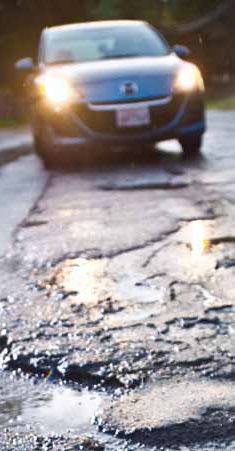Antioch Road Condition Drops to ‘Fair’
 The condition of Antioch’s 616 miles of roadway was dropped to “fair” this year in a Bay Area annual pothole survey. The latest rating of 69 (out of a possible 100) places Antioch pretty much in the middle of the pack in the Bay Area. But it dropped the city out of a “good” rating of 70, which Antioch had for the previous three years.
The condition of Antioch’s 616 miles of roadway was dropped to “fair” this year in a Bay Area annual pothole survey. The latest rating of 69 (out of a possible 100) places Antioch pretty much in the middle of the pack in the Bay Area. But it dropped the city out of a “good” rating of 70, which Antioch had for the previous three years.
The Bay Area jurisdiction with the highest-ranked pavement in 2010 is Brentwood, with a score of 86. This is the third straight year that this city in eastern Contra Costa County has finished at the top of the regional list. Brentwood’s 2010 score was a one-point improvement over its 2009 score of 85.
PCI scores of 90 or higher are considered “excellent.” These are newly built or resurfaced streets that show little or no distress. Pavement with a PCI score in the 80 to 89 range is characterized as “very good,” and shows only slight or moderate distress, requiring mostly preventive maintenance. The “good” category ranges from 70 to 79, while streets with PCI scores in the “fair” (60-69) range are becoming worn to the point where rehabilitation may be needed
to prevent rapid deterioration. Because major repairs cost five to 10 times more than routine maintenance, these streets are at an especially critical stage.
The condition of pavement on the Bay Area’s 42,500 lane-miles of local streets and roads is only fair at best, with the typical stretch of asphalt showing serious wear and likely to require rehabilitation soon. Data released today by the Metropolitan Transportation Commission (MTC) puts the region’s 2010
pavement condition index (PCI) score at 66 out of a maximum possible 100 points, as computed on a three-year moving average basis. This is unchanged from the 2009 reading, and is within two points of readings going back to 2006, leaving the region mired in a mediocre-quality range.
The 2010 pavement assessment is contained in a new MTC report on the region’s streets and roads. Titled “The Pothole Report: Can the Bay Area Have Better Roads?”, the report supplements the agency’s annual jurisdiction-by-jurisdiction ranking of the PCI scores of the Bay Area’s nine counties and 101 cities with a handy primer on the cost and life-cycle of pavement.
The report looks at some of the key factors that affect the condition of our roads, and catalogs the persistent and daunting challenges that confront public works departments in the region, including a serious need for greater funding. On a somewhat brighter note, The Pothole Report spotlights trends and technologies that make it possible to imagine a future where roads are not only smoother, but also safer and greener.
“The report documents the difficulties we face in maintaining our pavement, and identifies some promising new approaches,” said MTC Chair and San Mateo County Supervisor Adrienne Tissier. “That’s why we subtitled the report with a question. For a while now, the Bay Area has barely been holding its ground in terms of pavement quality. Clearly, we could do a better job. Whether we take the necessary steps is up to us as a region.”
The Bay Area locality with the lowest-ranked pavement in 2010 was the Solano County city of Rio Vista, which had a PCI score of 42, down three points from its ranking in 2009. Near the bottom is Orinda with a rating of 49.
MTC’s new Pothole Report is available online at www.mtc.ca.gov/library/pothole_report/. The report contains 2010 pavement conditions (based on the latest three-year moving averages) for all Bay Area counties and cities, as well as conditions for prior years.
the attachments to this post:





















